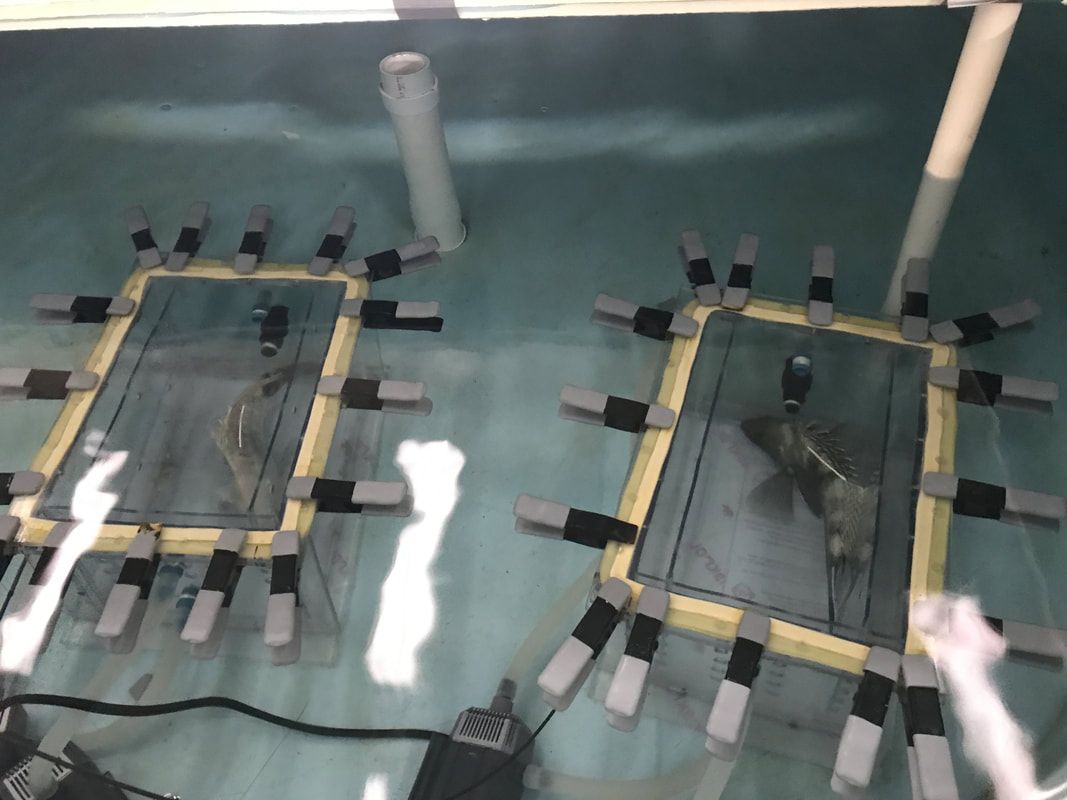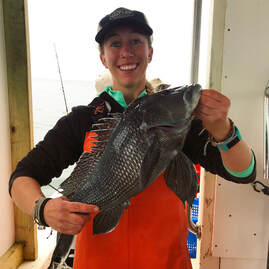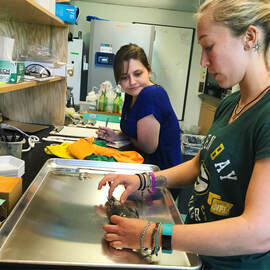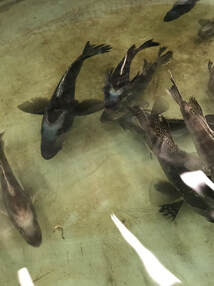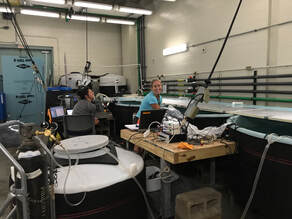PAST RESEARCH
Spawning Phenology of a Rapidly Shifting Marine Species Throughout its Range
The US Northern stock of black sea bass have become a poster child of rapid shifts of distribution poleward associated with recent open warming. Black sea bass spawning distribution spans from the coasts of Cape Hatteras, NC to, now, the Gulf of Maine. A large latitudinal distribution of spawning locations presents black sea bass with differing spawning conditions based on latitude and phenology. Due to differing photothermal regimes in these regions, spawning duration, timing, and output is hypothesized to be optimized for the specific latitudinal region. For example, at higher latitudes, fish typically have shorter spawning durations but compensate for a shorter spawning season with higher reproductive output per spawning event. We investigated whether black sea bass in the northern portion of their newly expanded range were able to match their reproductive strategies for their spawning location.
We found that black sea bass spawning duration and timing matched with the latitude they were spawning at, such that black sea bass in the southern locations had longer spawning durations than in the more northern locations. However, black sea bass in the northern locations had lower reproductive output, measured as a proxy from gonadosomatic index. This may be related to energetics and migration distance, a project that the is currently in the works!
To read more: Slesinger et al. 2021. Spawning phenology of a rapidly shifting marine species throughout its range. ICES Journal of Marine Science, fsaa252.
We found that black sea bass spawning duration and timing matched with the latitude they were spawning at, such that black sea bass in the southern locations had longer spawning durations than in the more northern locations. However, black sea bass in the northern locations had lower reproductive output, measured as a proxy from gonadosomatic index. This may be related to energetics and migration distance, a project that the is currently in the works!
To read more: Slesinger et al. 2021. Spawning phenology of a rapidly shifting marine species throughout its range. ICES Journal of Marine Science, fsaa252.
|
To collect black sea bass samples, we worked with local recreational fishermen to fish hook-and-line for some of our fish. This means that we got to go fishing!!
|
Afterwards, we dissected black sea bass to obtain a weight and a length, and then removed gonads, liver, and muscle tissue. Rutgers undergrads were taught how to dissect and were an integral part of the fish processing team.
|
The U.S. Northeast Shelf is experiencing rapid ocean warming with climate change, which is affecting many commercially and ecologically important fish species found in this region. A major response seen in fish populations is a northward shift reflecting fish seeking preferable temperatures. This northward shift has also been documented in black sea bass. However, this data is from bottom trawl survey data through NOAA NEFSC and may not completely represent the entire thermal habitat of black sea bass. Therefore, we investigated the effects of temperature on black sea bass through laboratory physiology experiments whose data can help inform these distribution maps based on thermal preferences.
We measured the maximum (MMR), standard metabolic rate (SMR), aerobic scope (AS), and hypoxia tolerance (Scit) of black sea bass at a range of temperatures (12-30C). We tested the performance of two different MMR methods, chase and swim-flume. Finally, we also tested the acclimation of potential of black sea bass by holding a subset of fish at 30C for one month before running them in experiments. We found that the flume method for MMR performed better than the chase, and used this value to calculate the AS. Black sea bass had a thermal optimum at 24.4C. The Scrit slowed us to calculate the Metabolic Index (MI), a measure of environmental oxygen supply to animal oxygen demand. The MI, however, indicated that 24.4C was not necessarily optimal but an upper tolerable temperature. We expect to see black sea bass continue to expand northward as the bottom temperature in the southern portion of their range warms.
To read more: Slesinger, et al. 2019. The effect of ocean warming on black sea bass (Centropristis striata) aerobic scope and hypoxia tolerance. PLoS ONE, 14(6), e0218390.
We measured the maximum (MMR), standard metabolic rate (SMR), aerobic scope (AS), and hypoxia tolerance (Scit) of black sea bass at a range of temperatures (12-30C). We tested the performance of two different MMR methods, chase and swim-flume. Finally, we also tested the acclimation of potential of black sea bass by holding a subset of fish at 30C for one month before running them in experiments. We found that the flume method for MMR performed better than the chase, and used this value to calculate the AS. Black sea bass had a thermal optimum at 24.4C. The Scrit slowed us to calculate the Metabolic Index (MI), a measure of environmental oxygen supply to animal oxygen demand. The MI, however, indicated that 24.4C was not necessarily optimal but an upper tolerable temperature. We expect to see black sea bass continue to expand northward as the bottom temperature in the southern portion of their range warms.
To read more: Slesinger, et al. 2019. The effect of ocean warming on black sea bass (Centropristis striata) aerobic scope and hypoxia tolerance. PLoS ONE, 14(6), e0218390.
The Effect of Ocean Warming on Black Sea Bass Aerobic Scope and Hypoxia Tolerance
|
Black sea bass in individual respirometers used to measure oxygen consumption, a proxy for metabolic rate.
|
|
